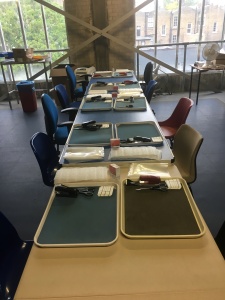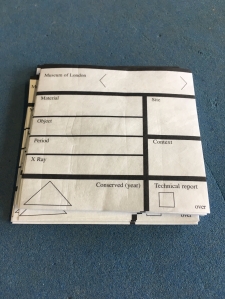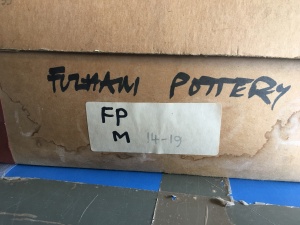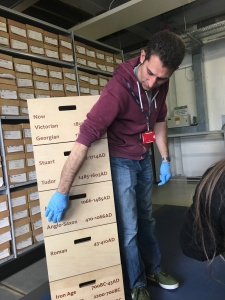As I walk out of Old Street Tube and up past Shoreditch Park it comes flooding back to me, the excitement of my own Volunteering Inclusion Project back in 2013. I loved every minute of it and I wonder about the young people on our project, whether they feel the same excitement. But I am very aware of how easily excitement, anticipation and nerves can turn into anxiety. Anxiety so overwhelming that it stops involvement and enjoyment.

All set up and ready to go
Week 2 is actually Week 1 in a way, it is the first full day for our young autistic adults from CASPA. The previous week was more of a shorter pre-visit which you can read more about here – https://tinctureofmuseum.wordpress.com/2017/04/26/week-1-unicorns-and-mermaids-team-caspa-the-pre-visit-volunteering-at-the-museum-of-london/ I am a little nervous myself as I arrive at Eagle Wharf Road, will the group turn up?
It doesn’t take long to dispel my worries as I find one member of the group is already waiting in the foyer. She is on a supported programme run out of the London South East Colleges (previously Bromley College) that is preparing her for work. Her tutor Giles has come with her today but the aim is that next week she will travel in on her own. Giles tells us it is the furthest placement from Bromley they have had for a student and he is keen to see what she will be up to and what goes on in the archive.
 The rest of the group travel in together supported by a member of CASPA. We begin the day with the kind of thing most people experience in an new job – admin! There is a little bit of form filling and Adam Corsini, Archaeology Collections Manager, goes through some of the museum documentation. There is a volunteer handbook and supportive safeguarding, equality and discrimination policies that all workplaces have.
The rest of the group travel in together supported by a member of CASPA. We begin the day with the kind of thing most people experience in an new job – admin! There is a little bit of form filling and Adam Corsini, Archaeology Collections Manager, goes through some of the museum documentation. There is a volunteer handbook and supportive safeguarding, equality and discrimination policies that all workplaces have.

Words can be confusing
He explains a little about how the museum works and the aims in reaching different audiences and visitors. I particularly like it when he explains the museums efforts to ‘stand on our own two feet’ actually means to become financially independent. Autistic people often take language very literally and this is a great example of the kind of confusion that can occur.
 He talks through safety and security and the access passes each member of the group will have to get around the building. I love the attention to detail by one member of the group when he notices Adam’s pass has a future date on it. Instead of realising it is the date the card expires he asks how the card could have been made in the future. It is this kind of literal interpretation that is making me stop taking things for granted and opening up the work we do and the communication we have.
He talks through safety and security and the access passes each member of the group will have to get around the building. I love the attention to detail by one member of the group when he notices Adam’s pass has a future date on it. Instead of realising it is the date the card expires he asks how the card could have been made in the future. It is this kind of literal interpretation that is making me stop taking things for granted and opening up the work we do and the communication we have.
It is also why it is great experience to do simple things like form filling, terms like ‘Print your name’ actually means put your name into capital letters. I am hoping experiencing these kinds of situations will help the group as they move forward into further education, work or new volunteering positions. Hopefully we can also feed back to our Human Resources team ways to make forms more self-explanatory.

All ready for our first bag.
Finally we get down to some actual work! We begin by re-packing one bag each as a group, going through the stages one by one. We are opening existing bags and removing fragments of 17th century Fulham Pottery and any labels that go with them. Adam is teaching the group to really look at what they have: any medallions or shapes, the different glazes inside and out, the curves of the pot that may indicate a rim or a base, the ridges inside the pot that show it was thrown on a wheel.

New labels ready to be filled in.
New labels are filled out including object number, which will be different each time. This can usually be found on the object and should correspond to the number on the original bag and original labels. We add a site code – FP71 which stays the same and stands for Fulham Pottery and the excavation date which is 1971.


Lets learn about context or layers of a cake (as I like to think about it)
To find the context number (which pin-points the place in the ground where the object was found) we need to find the object number on a separate printed list. We then stamp on the material and object type on to the label, the stamps need to be lined up to make sure the information goes in the right box.

Protected but still easy to see to minimise handling
A section of foam is folded into three and cut and a third fits into a new small bag perfectly. Pottery is placed on one side of the foam and old labels on the other. The bag is folded in half and stapled, the folded over flap always covers the old label rather than the object so it can be seen easily. The final step is to staple the new label to the inside of the folded over section. They are stapled just to one side so if you need to open the bag up at a later date the label will remain attached. When a box has been completed the bags are filed in object number order.
I have described the process in detail for a number of reasons. Firstly to show that these are all transferable skills to be used in the work place. Attention to detail, accuracy, writing neatly and clearly, listening to instructions, cross checking information and entering data in a form. Also this is a real job making a real difference to the archive. Objects are better packed and protected, they are easier to find for future researchers, contextual information is being added and working in this way often makes more space when the bags are packed into new boxes.

Getting a look in the Glass and Ceramics store
With one bag packed as a group, and after a quick lunch, we are back into packing with gusto. The repetition making the task more familiar. As a final treat on our first full day Adam takes the group into the Glass and Ceramics store to see complete examples of pottery, ceramics and glass from all over London, in time and place. We got to see some complete examples from Fulham Pottery and got an understanding of how the fragments we are working on become part of the whole.
After a thoroughly enjoyable day the group seem up-beat and confident now work has finally got underway.
xxxxxxxxxxxxxxxxxx
You can read more about the project here – https://tinctureofmuseum.wordpress.com/?s=teamcaspa












Comments 1
It’s a shame you don’t have a donzte button! I’d most
certainly donate to this brilliant blog! I guess for now i’ll settle for book-marking andd adding
your RSS feed to my Google account.I look forward to fresh updates and will talk about tis
website with my Facebook group. Talk soon!